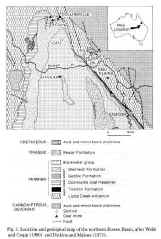International Journal of Coal Geology, 7 (1987), 365-388
COLD-CLIMATE, FLUVIAL TO PARALIC COAL-FORMING ENVIRONMENTS IN THE PERMIAN
COLLINSVILLE COAL MEASURES,
BOWEN BASIN, AUSTRALIA
I. PETER MARTINI1 and DAVID P. JOHNSON2
lDepartment of Land Resource Science, University of Guelph, Guelph,
Ont. N1G 2W1, Canada
2Department of Geology, James Cook University, Townsville, Qld., 4811
Australia
¡¡
 The Middle Permian Collinsville Coal Measures of the northern Bowen Basin
illustrate a range of cold to cold-temperate, coal-forming environments. Cold
climate is indicated by Glossopteris flora in the coal measures, and by
restricted marine fauna dominated by brachiopods and bryozoa in correlative
marine sequences of the Back Creek Group which contains also abundant lonestones
(dropstones). Sedimentation was characterised by an overall transgression,
interrupted by local fluvial and coastal progradation in a shallow,
epicontinental sea during a relatively quiescent tectonic period.
The Middle Permian Collinsville Coal Measures of the northern Bowen Basin
illustrate a range of cold to cold-temperate, coal-forming environments. Cold
climate is indicated by Glossopteris flora in the coal measures, and by
restricted marine fauna dominated by brachiopods and bryozoa in correlative
marine sequences of the Back Creek Group which contains also abundant lonestones
(dropstones). Sedimentation was characterised by an overall transgression,
interrupted by local fluvial and coastal progradation in a shallow,
epicontinental sea during a relatively quiescent tectonic period.
Six sedimentary
environments are represented: fluvial, fluvio-paralic, barrier-strandplain,
back-barrier, tidal flat and open marine. The basal coal formed from peat of
swamps of abandoned areas of gravelly braided streams, and is massive, dull, and
with high ash (20%), low sulphur (1%) contents. Overlying coals developed from
peats formed in fluvio-paralic and paralic environments, and thicker seams are
generally brighter, with low to moderate ash (8-17%) and moderate to high total
sulphur (1-6%) contents. Seams associated with fluvial influence show splits and
high ash yield, while seams associated with coastal deposits show high sulphur
levels (up to 21%).
In contrast to reported models of coal-forming environments,
no clearly defined deltaic or interdistributary bay-fill sequences were
identified in the area studied. Rather, vast freshwater wetlands backed low
gradient, progradational coasts locally having bars and barriers. The barriers
were not prerequisites for substantial peat accumulation, although may have
locally assisted peatland development by raising the profile of coastal
equilibrium.